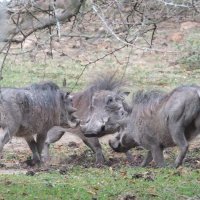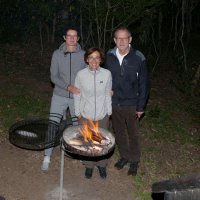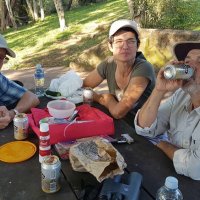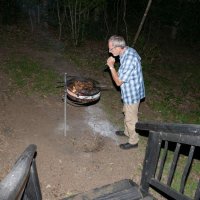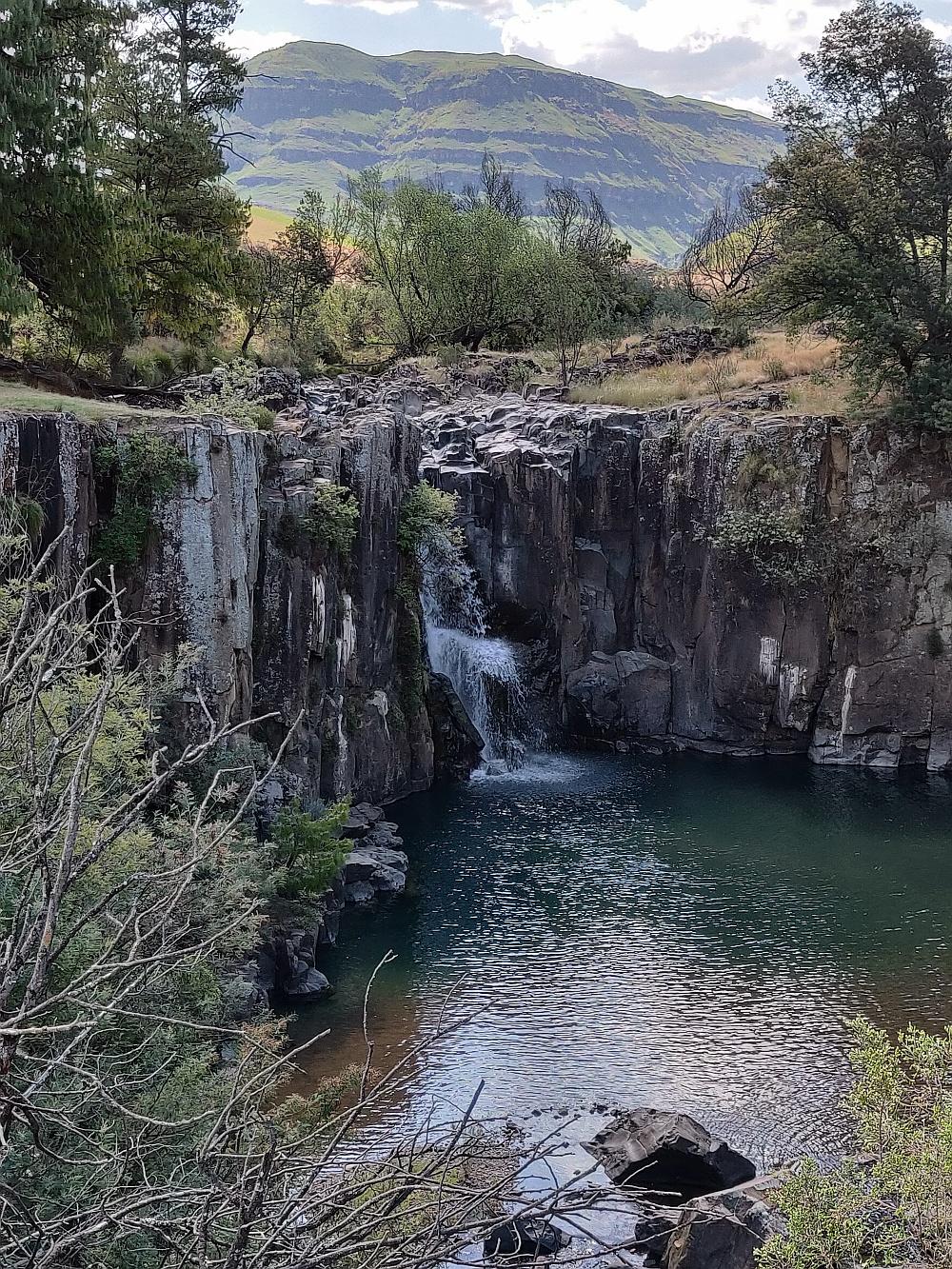
with Edda and Hermann in South Africa's East
A pretty waterfall near our hotel at the Sani Pass.
Caused by our travel-stories, we had awakened in my sister Edda and brother-in-law Hermann a desire to visit South Africa. Their previous african experiences were based on a group trip to Tanzania, which they had enjoyed very much and probably made them want to do more. We offered them to explore eastern South Africa with us for two weeks.
Arrival in Durban and Balito
Ballito is a holiday-resort town (20 000 inhabitants) on the coast of KwaZulu-Natal and is located about 40 kilometers north of Durban. Because dolphins are regularly sighted in the coastal region around Ballito, this area is also known as the Dolphin Coast.
The vehicle pickup at King Shaka Airport, Durban, went smoothly. In our white Toyota Fortuner we arrived in the afternoon at the B&B accommodation in Ballito, which we had booked 9 months ago and which looked a bit deserted at first sight. The owners' daughter explained to us that the house had been sold and that we were the last guests before the handover to the new owners. The rooms were nevertheless attractive and clean, the breakfast the next morning, rich as usual. In the evening we visited our "regular" restaurant Mo-zam-bik, whose owner Brett Michelin we know personally from a previous trip. The next morning we stocked up on supplies including wine and beer in the top modern shopping center and started the tour with a visit to Ballito Beach with its tidal pool.
Hluhluwe-Umfolozi Game Reserve.
The drive to Hluhluwe Game Reserve takes approximately 3 hours.
The game reserve is rather smaller in area (960 km²), but is the second oldest game reserve in Africa. The terrain is predominantly hilly. The park is named after the two rivers, Hluhluwe and Mfolozi, which flow through it.
The "Big Five", elephant, rhino, buffalo, lion and leopard are present in the park as well as cheetahs, wild dogs, giraffes and nyalas. Hluhluwe and Imfolozi were established as separate game reserves in 1895.
By the early 1960s, the white rhino (Ceratotherium simium) was threatened with extinction, and the world's last known occurrence in the wild existed at Imfolozi. Operation Rhino, conducted by the KwaZulu Nature Conservation Service, captured specimens and sent them to reserves and zoos around the world, and global populations have since recovered. Today, similar efforts are taking place with the black rhino (Diceros bicornis).
In 1989, the two areas were combined with the separating road corridor to form the present park.
Our plan is to devote ourselves first to the northern section of the park, Hluhluwe. In the large and with everything (restaurant, store, gas station, pool) equipped Hilltop Camp we have booked two 2-bed chalets, which are however not directly next to each other. The equipment with bedroom, living room, attached kitchen, bathroom and terrace is good. However, a renovation would be appropriate. We later saw that about half of the houses have already been renovated. In the process, the thatched roofs were also completely renewed. Our booking included breakfast on the terrace of the restaurant.
In the evening we threw on the grill and enjoyed the southern starry sky on our veranda with a sundowner and cold Castle.
During an evening walk we met a biologist who researches the life of scorpions. To see the animals at night he uses a black light lamp. In the UV light the chitinous shells of the scorpions glow in brilliant white and are then relatively easy to spot.
A few more animal photos:
In the southern part of the park, the Mpila Section, only self-catering accommodation is offered. One has the choice between chalets and safari tents. We chose the tents because of the safari feel.
Each tent stands on a spacious wooden platform. The "bathroom" is in true style in the "open air", of course with appropriate privacy protection and running hot and cold water. The kitchen is located in a separate kitchen tent and is fully equipped. The special thing about this camp is that it is only protected from large animals by an electric fence about 2.50 m high. All "small animals" like monkeys, hyenas or even lions have quite "visiting possibilities".
Drinking water and other small things can be bought in a kiosk-like little house. Firewood was unfortunately not available. Collecting firewood is generally forbidden in the parks. Therefore, we had to leave the park once again and buy the needed firewood from the merchants on the thoroughfare.
At the park entrance we were warned that especially hyenas visit regularly to possibly help themselves to the barbecue food. One could drive them away easily by throwing stones. Hermann heeded the advice and stocked up on projectiles on his terrace.
When the hyenas actually came, we were too busy taking pictures and looking to be able to throw stones. Since we had already eaten our meat, the animals had to leave hungry.
iSimangaliso Wetland Park
The iSimangaliso Wetland Park is a protected area on the east coast of the South African province of KwaZulu-Natal. With an area of 1,328,901 ha, it is the second largest protected area in South Africa after Kruger National Park. It was declared a World Heritage Site by UNESCO in 1999. The national park extends north to Kosi Bay on the border with Mozambique and consists of many smaller protected areas of subtropical and tropical vegetation, with 5 closely spaced ecosystems. A highlight is Cape Vidal, a remote dream beach with snorkeling opportunities and almost deserted miles of sandy beaches.
The entrance to the park is located near the small town of St. Lucia where we stay at the Elephant Guesthouse. It is run by a family of Dutch origin. We enjoy the opulent breakfast with a tropical-garden-view, where small monkeys cavort. While Edda and Hermann treated themselves to the obligatory boat tour of Lake St. Lucia, enjoying hippos, crocodiles and sea eagles, we played St. Lucia's Monzi 9-hole golf course for the first time. Good value for money. You have two tees on each hole. Not spectacular but relaxing!
On our trip to Cape Vidal, we made extensive use of the 6 loop roads that branch off from the main road and offer excellent wildlife viewing opportunities. After 2 hours we reach Cape Vidal, which is located at the southern edge of the St Lucia Marine Reserve, which extends to the border with Mozambique.
In the protected bay many anglers pursue their hobby. Especially saltwater fly fishing seems to be very popular.
During low tide, countless "rock pools" form, which are excellent for fish and crab watching. The miles of natural sandy beaches invite long walks. It's a pity that we always spend such a short time there.
Drakensberg, Sani Pass
From St. Lucia we return to the airport in Durban to exchange our Toyota Fortuner for 2 small cars. This way we are more independent and have the possibility to drive to separate destinations. Our next destination on the way to the Drakensberg is the capital of the province KwaZulu-Natal, Pietermaritzburg (230 000 inhabitants). During World War I, Pietermaritzburg was the site of a concentration camp for German prisoners from the German colonies in Africa. A large number of these prisoners came from Lüderitzbucht in German Southwest Africa, now Namibia.
The city's British past is visible in the form of typical parks and gardens and numerous large, well-preserved colonial buildings. The City Hall, built in 1893, with a 47-meter bell tower, is a wellknown landmark. Gandhi, a pacifist, was expelled from the whites-only compartment of a railroad train near the city in 1893 in his capacity as a member of the Indian-origin population, which had a decisive impact on him and ultimately led to the Satyagraha political strategy. A statue was erected in his honor in front of the Colonial Building, unveiled by Archbishop Desmond Tutu on June 6, 1993.
We enjoy the sights only in passing, on the way to our accommodation in a suburb. We stay in a kind of garden cottage with a balcony. Somehow quite funny. For dinner we treat ourselves to the (according to Tripadvisor) No1 restaurant Olive & Oil in the Cascades Shopping Centre.
On the way to Sanipass, the high mountain border crossing to Lesotho, we pass through Midlands Meander, a very popular weekend getaway destination among the locals. We make a sightseeing stop at Howick Waterfall, where there is quite a bit of weekend activity. Howick is where Nelson Mandela was imprisoned in 1965 and subsequently imprisoned on Robben Island for 27 years. The Nelson Mandela Capture Site and the small museum are also well frequented by visitors.
As the drive continues, the asphalt roads end. We have to adjust to the gravel roads that twist and turn towards the Drakensberg Mountains towering in front of us. There are not many turnoffs, but we still manage to get lost. We stop at the Nottingham Road Brewing Company, a craft beer brewery, test the beer and the house-distilled gin, and take a bottle as a souvenir. We meet Edda and Hermann again shortly before we reach our destination for the day.
For the first time on this tour we booked a real hotel stay, bed and breakfast at the Premier Resort Sani Pass. The hotel is located outside the village of Himeville, just off the road to Sani Pass.
The Sani Pass, is with 2873 meters the highest pass in South Africa and leads to Lesotho. It is only allowed to drive with 4x4 vehicles. The access road is closed with a barrier. We drive up to the barrier, but do not book one of the organized trips offered. Instead, Edda and Hermann opt for a mountain hike, we take a trip to Himeville, where we discover an excellent little boutique hotel, the Moorcroft Manor. Lunch on the garden terrace is delicious, and the service is extremely friendly. If we were to come here again, this would be our first choice.
Our hotel has a 9-hole golf course, which we want to play. However, the condition of the signage is so catastrophic that we give up playing after 2 holes, unnerved, because we simply do not know where to go. Too bad.
Oribi Gorge
On our way back to the sea from Sani Pass, we make a quick stop at Oribi Gorge, an impenetrable canyon off the mouth of the Mzimkulu River.
"West of Port Shepstone, the Mzimkulu River has carved a magnificent canyon over millions of years. Geologists celebrated it as a minor sensation when rocks over a billion years old were found on the valley floor; archaeologists continue to discover San drawings in the caves and under the rock overhangs from the hunter-gatherer era that ended in this part of the world only a hundred years ago."
The nature reserve is rather small and still an insider tip. Only a few tourists come to enjoy the magnificent view of the gorge or to hike on the Baboon trail through the Afromontane forest. We limit ourselves to a short walk along the canyon rim. There is also a device for bungee jumping set up there. We can watch a jump. I definitely didn't want to jump myself. I don't have the courage for that!
Ramsgate, Indian Ocean
At the end of our trip we relax for 2 days in Ramsgate, at the Indian Ocean. Ramsgate is a village on the south coast of KwaZulu-Natal, south of Durban. It is located at the mouth of a river, and offers beautiful beaches as well as varied hiking trails. The hiking trails are used intensively by Edda and Hermann, while Sabine and I play the golf courses "San Lameer" and "Southbroom" for the third time. They are simply beautiful. We stay at Wailana Beach Lodge with Renate and René, two Swiss who have been running a B&B for several years and whom we already know from previous stays. From the terrace with ocean view, Edda and Hermann can also see passing whales for the first time.



